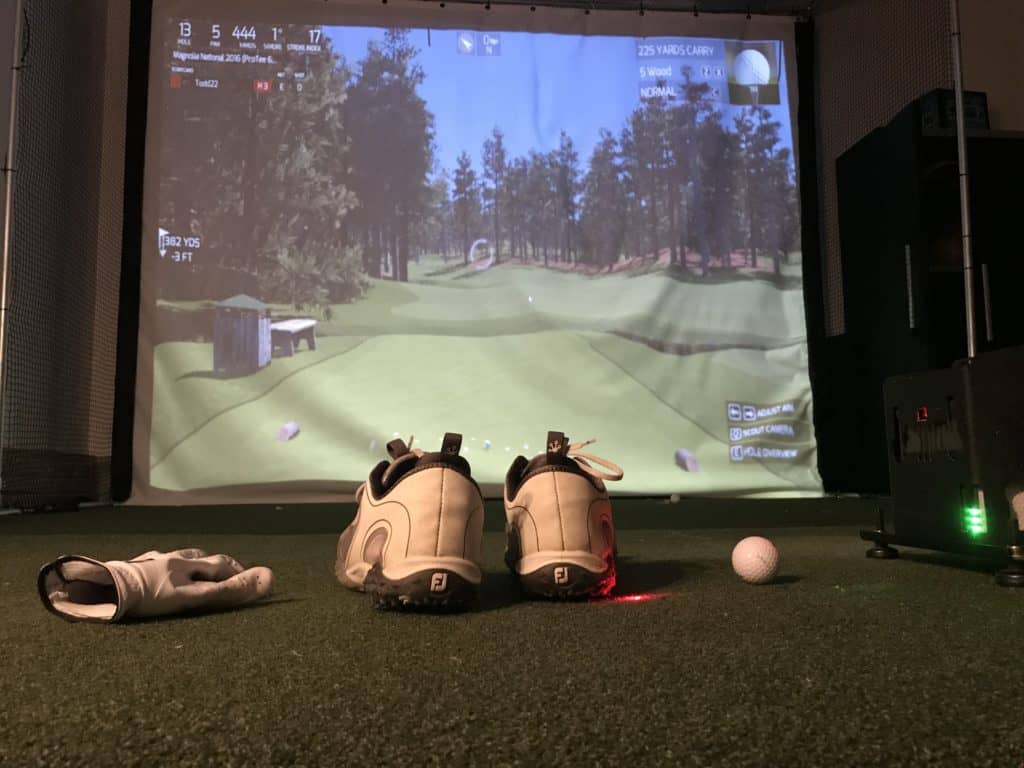Golf can be one of the most difficult sports to learn.
Some golfers are fortunate enough to start as young kids and learn along the way. The game seems to come more natural for those that start at a young age.
Others start the game as a teenager or even as an adult. They are a bit behind, but can still learn the game at a high level.
I am here to help!
Those suited to make a quick adjustment and start playing decent golf are those that have played other sports like baseball or hockey. The swinging motion used in these two sports carry over to golf.
Below, I will dive into 11 steps you can use to learn golf and to become proficient at it quickly.
It of course will take some time and dedication, but shooting in the 80s isn’t too far off for those that are decent athletes and have played other sports as a kid or even as an adult.
Many people want to learn to golf because it is a lifetime sport that can be enjoyed with family and friends. You get to spend quality time outside in the middle of a beautiful landscape challenging yourself both physically and emotionally.
Golf is the ultimate journey and an amazing sport. Here at golfjourney365, we love the game of golf and everything that it provides us, most notably the challenge to grow and improve as a golfer!

What Is The Best Way To Learn Golf?
Follow these 11 steps to learn to golf:
- Take a lesson
- Study the golf swing
- Understand the fundamentals
- Practice the golf swing
- Seek feedback on progress and assess your game
- Focus on the short game
- Set monthly goals
- Train for speed
- Utilize drills
- Get fitted for clubs
- Have fun!
Step 1: Take A Lesson
Whether you are brand new to the game or have played previously, it never hurts to take a lesson to ensure you have some items to work on. Hopefully, your instructor will provide a complete assessment and leave you with some drills you can work on between lessons.
Understand that it may take several lessons and I would highly recommend buying a package of lessons for anywhere between 3-6. I would spread these lessons out about a month apart. The key is to practice the drills or technique the instructor gives you.
Doing nothing between lessons will not help you progress. Don’t waste your money if you can’t head to the driving range at least once a week to work on your technique or drills.
I get to golf with a lot of former athletes that have some quality swing speed, but have horrible technique. The best approach for these golfers would be to buy a package of lessons and commit to make some quality progress in that first 3-6 months.
There are many different approaches to the golf swing, but initially the goal is to learn about the swing and have a system you can rely on! The lesson will get you headed in the right direction.

Step 2: Study The Golf Swing
If you want to get good fast, you must understand the golf swing. Yes, if you follow step one and take a lesson you are on your way, but there are some quality instructors on youtube that can give you a quality understanding of the golf swing.
You have to be careful not to mix instructors up as some have different approaches.
Some of the different approaches come from what they believe drives the swing. You have golf instructors in the arm driving swing camp and those that believe the legs and body drive the swing. Is either one necessarily better?
I don’t think so and believe you can have success with either approach.
I would recommend finding out the philosophy of the person you have taken lessons from and start to learn more and more about the golf swing that you are learning.
Here are some golf instructors that have some amazing online content that fall into the different camps. Check out the links below for a full review on these online golf instructors:
Momentum Driven Swing:
Arm Driven Swing:
Body Driven Swing:
Alternative Golf Swing:
Step 3: Understand the Fundamentals
The Stack and Tilt Instructors said it best when they described what they believed were the fundamentals of golf. They explained it somewhat similar to this:
- Fundamental #1: The golfer’s ability to control the bottom of the golf swing. The best golfers will hit the ground in the intended spot, close to 100% of the time.
- Fundamental #2: The golfer’s ability to control the curve of the golf ball. The best golfers are able to start the ball to the right or left of the target line and have the ball curve towards the target without the ball over curving past the target.
- Fundamental #3: The golfer’s ability to have enough power to play the golf course. This means they are able to hit the ball far enough to play the course in regulation.
The bottom line is that you must be able to strike the ball solid (fundamental 1), control the start line and curve of the ball (fundamental 2) and have enough speed/power (fudnametnal 3) to play the golf course.
Fortunately, I have a drill for each of the fundamentals above:
Drill: The Low Point Control Drill (Fundamental 1)
- Take some yard paint and patina a 1-2 yard long line.
- Setup with 55% of your weight on your front side.
- Try to hit the target side of the line and see how many times out of 10 you can do this successfully!
- Repeat this drill every day for a month, tracking your progress and your ability to to this successfully in trials of ten.
- You may need to start with half swing and progress to full swings.
Drill: Develop A Stock Shot (Fundamental 2)
- At the driving range, set up an alignment stick about 6-8 yards in front of you, straight down your target line.
- If you have a second alignment stick, set the stick 3-4 yards right of the first stick (for a draw) or left of the first stick (for a fade).
- Complete your initial assessment see how many times out of 10 you can start the ball to the right or left of your target. Pick one side and measure your game at this point.
- The goal is to eventually get 7 out of 10 shots to start to the correct side and draw back towards the target.
Here is the drill being explained by Kyle Morris:
Drill: Train for Speed (See Step #8 below)
Step 4: Practice the Golf Swing
In any learning cycle, whether someone is learning something at school or learning how to drive, it takes repetitions with the learning that has taken place.
Now that we have taken the lesson, learn more about the golf swing, and understand the fundamentals with some drills that can be applied it is time to practice our learning.
Sitting around and watching videos all day will help you grow your understanding which is important, but we also need to make sure we are practicing our golf swing.
Utilize the drills I have provided above or drills that your golf instructor have given you. Continue to assess your progress and document your swing thoughts and challenge yourself with different games to monitor your progress.

Step 5: Seek Feedback on Progress and Assess Your Game
Any learning needs feedback from the instructor or a self assessment that can be utilized to help you monitor your progress. I would recommend seeking feedback through video and assessing through different drills.
For example, drill 1 listed above. See how many times out of 20 you can strike the ground on the target side of the line. Complete this drill at least once a week and record what your success rate is.
It should be better by month number 2 and 3 and you know that you are making progress towards better ball striking.
Also, assess yourself on your stock shot. Can you start the ball to the right of the target even 3 out of 10 times. This is a drill that as a scratch golfer I continue to use on a weekly basis.
Regardless of your ability level, it is a great drill and a quality assessment for some excellent feedback on your progress.
Go out and play a round of golf, record how many solid shots you hit, how many putts you take and how many bogeys you make.
Keep track of these numbers over time. Record your overall score for the ultimate assessment, but understand there are different benchmarks along the way that show progress even if your scoring does not yet show up yet on the scorecard!
Step 6: Practice Your Short Game
The quickest way to shoot the best scores possible, especially early on in your golf journey is to practice your short game. Work on the basic chip shots and putting.
For chipping, learn to chip with one of your wedges. Keep the motion simple and work on getting the ball in the air and going in the direction of the hole.
For putting, work on your 3-10 footers and your putts over 30 feet. This will give you the biggest possibility for improvement.
An awesome game to play and another way to assess your growth is to take one ball and chip it on the green and see if you can get it in the hole with one putt or a total of two strokes. Do this 20 times and record how many times out 20 you are successful!
This is another drill you should play as often as possible to assess your growth. Make sure you record in a journal.
Step 7: Set Monthly Goals
See monthly goals for the following:
- How many times out of 20 can you be successful with drill 1.
- How many times you can be successful with drill 2 out of 20 times.
- Set a goal for your swing speed (see step 8 below)
- Set a scoring goal for your next round.
- How many times out of 20 can you get up and down on the short game drill above.
Step 8: Train For Speed
We all want more swing speed in our golf game. Many of us have read or heard about the analytics related to golf and the importance of additional speed and distance in our game. If you can’t hit the ball over 225 yards with the driver, reaching certain levels like low single digits can be difficult.
The good news is that there are numerous options to help you improve your swing speed regardless of age. The most recent science to hit golf is the overspeed training.
The most popular and the one that I use is SuperSpeed Golf. This overspeed training approach has multiple training protocols that only take 15 minutes every other day.
Find a place at your house where you can swing the speed sticks and gain 5-8% as early as the first training session. Make this stick and become your normal speed by training for several months. Over the course of time, you can expect to add an additional 1% every couple of months on top of the 4-6%.
A year ago my average driving swing speed was between 99-101 miles per hour. I am now playing the game between 103-107 miles per hour. Just the other day I hit two drivers that went 285 yards in some soft, no wind conditions.
This means to me that I really did connect and have been able to add additional speed through the overspeed training and by studying and implementing the swing practices of George Gankas!
Are you ready to get started today with SuperSpeed Golf? Build that stock shot, train for more speed, don’t forget about the short game and before you know you will be shooting your goal score!
- Check out SuperSpeed Overspeed Training Protocols
- Train every other day for 10-15 minutes.
- See a 4-6% increase in swing speed as early as the first training protocol.
The number one thing that has helped me gain significant distance is the SuperSpeed Training System.
Step 9: Utilize Drills
Make sure you continue to use drills on a weekly basis. Don’t fall into the trap or using block practice at the range for every session. Block training is where you hit 10 – 7 iron in a row or 20 drivers.
Something where you consistently hit the same club time and time again.
Here are 7 drills you may consider using!
Utilize different drills and play different driving range games. My favorite is to play a golf course in my mind at the driving range. I picture the far right and left boundaries of the 1st hole and hit my drive.
I estimate what I would have left for my approach shot and pick a reasonable target on the range.
I continue this process for all 18 holes on the course. This helps build some skill in producing shots and keeps you out of block practice.
Block practice has a time and place, but as your progress with the game make sure you work in different drills and mini games to challenge your growth!
Step 10: Get Fitted For Clubs
Make sure you have quality equipment. Golf is difficult enough, golf is even more difficult with poorly fitted clubs or the wrong clubs overall. Take some time and make the investment in getting fitted for clubs.
If you can’t afford this, at least have a driver that is not older than 5 years and irons that are not older than 10 years. Technology continues to evolve and it is important to have above average clubs.
Step 11: Have Fun!
Keep in mind that golf is supposed to be fun. Enjoy the journey and play golf as often as possible! Take pride in your progress and understand that there will be ups and downs in your progress.
Keep working on the drills and following the advice above!
Final Thoughts: My Secret To Golf Improvement
Let’s face it, in order to get really good at golf, we must practice frequently. About three years ago, I made the leap and invested in a golf simulator build for my garage.
I went with a SkyTrak Launch Monitor and the TGC software and can now play over 100,000 courses including Augusta, Pebble Beach, Bethpage Black, Whistling Straits. St. Andrews and many other of the top 100 courses in the world.
This golf simulator setup, which is more affordable that you might imagine, has been a game changer. I can now play golf everyday of the year regardless of rain, snow, cold weather or time of day. I can practice or play rounds of golf.
I can stand in the 11th fairway at Augusta and with the auto-rewind feature I am able to practice my approach shots from various differences.
It is worth checking out through Rain or Shine Golf as they offer some incredible packages along with financing offers that are difficult to beat.
Some direct links to Rain or Shine Golf for pricing and financing:

I am an amateur golfer on a journey to get better, enjoy the game as often as possible and share my passion and knowledge with others. I have coached high school golfers at a high level and have a great passion for the game and want to give back. I enjoy learning about the golf swing and am currently studying to be a certified professional golf instructor. Join me in our journey to get better everyday. Thank you for reading!

